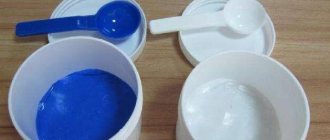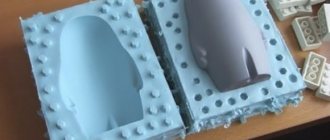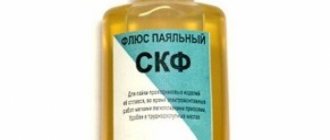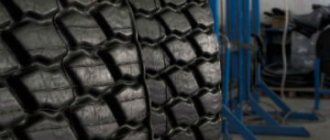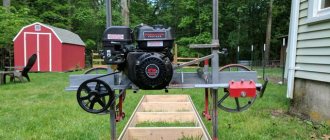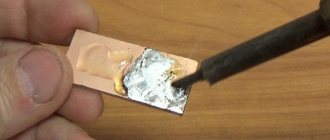Good day, dear readers. In today's article I will talk about travel products made from waterproof fabrics and how to make them yourself. These days, hydrophobic materials are ubiquitous, used in the manufacture of a wide variety of things - from tents to bags, from sneakers to down jackets. Meanwhile, water resistance is an unstable property; it quickly disappears. And buyers do not always understand how to properly care for waterproof items and how to replace them if necessary.
From the article you will learn:
- how manufacturers make travel clothing waterproof;
- how long its properties last;
- what products for restoring waterproofness are commercially available and how to use them;
- how to make your own water-repellent fabric;
Let's start.
DIY water-repellent impregnation methods
- The first way is using available chemical solutions. With this processing of matter, its threads become impermeable to liquid, but the gaps between them are not filled. This is how denser waterproof fabrics are processed, thereby increasing their fire resistance. A well-stretched tent made of impregnated material with a roof angle of at least 35° does not let raindrops through. But if things lying in the tent come into contact with the fabric, then water penetrates through the pores and they get wet. Impregnation should be renewed every year if the travel season is quite long and there is a lot of rain. Ropes and slings can also be impregnated using chemical methods so that they also do not get wet or rot.
- The second method is water-repellent impregnation of textiles with an oil or wax-like composition that fills all gaps. As a result, it becomes completely impenetrable to air and water, but at the same time, it becomes heavy and flammable, and at low temperatures it is not flexible. Sparks can easily burn through it or even cause a fire. Materials used mainly for the floor of a tent, the lining of pack bags and bags, and sometimes backpacks are subjected to this method of processing. When handled with care, this waterproof fabric retains its waterproof properties for several years.
- The third (intermediate) method is to apply a composition containing fish or wood glue or casein. As a result, the material becomes dense and suitable for making both clothing and tents, as well as lightweight flooring (for example, a recipe with wood glue).
Results
Waterproof clothing is indispensable for a traveler; it is used almost everywhere. Only the materials used differ.
Still, I would not recommend using a homemade method to give water-repellent properties to hiking clothes, because we must be prepared for any natural phenomena and situations while hiking, and it is clothes made of membrane fabrics that will guarantee us comfort and such confidence.
To some, the membrane may seem too difficult to maintain and unreasonably expensive. But as they say, “the end justifies the means” and your comfort, especially on a hike, is priceless. Personally, I use clothes made from membrane materials all the time. Both for short country hikes on a rainy day and for serious mountaineering outings, the membrane is ideally suited as a second layer, and thermal underwear will be the first. If you are an active tourist or athlete, then thermal underwear and clothing made from membrane materials should become your “second skin.”
That's all I have. If the information was useful to you, do not forget to subscribe to blog updates and share with friends on social networks. See you!
Available Chemical Waterproofing Compounds
- Dissolve 500g of laundry soap in 5l of boiling water. Soak the material well, then squeeze lightly. Without drying it, immerse it for a while in an aqueous solution of ordinary (potassium-aluminum) alum (500g per 5l, and for stronger impregnation you can take 1000g). Dry without wringing.
- Dissolve 450g of laundry soap in 4.5 liters of boiling water, add 250g of laundry soda and 450g of rosin powder. The processing procedure is the same. Both of these methods are good, but the first is simpler and faster (suitable, in particular, for fishing nets).
- One of the simplest and most effective methods, which also makes it possible to make waterproof fabric with fire-resistant properties, is impregnation with alum and lead sugar (lead acetate). In one 3-liter container, 150 g of lead sugar is diluted, in another, in the same volume, 150 g of ordinary alum (or another option - 75 g of both products for the same amount of water). They need to be allowed to settle and drained together, separating them from the sediment. Let the resulting emulsion stand for several hours, and then, when the liquid becomes clear, drain it, separating it from the sediment. Soak the textiles in this liquid overnight or even a day, and then dry without wringing. Since the composition is poisonous, the dishes should be thoroughly boiled and washed.
- Dissolve 400g of alum in 2.25 liters of boiling water, add 9.125l of H₂O at room temperature. Soak the textiles in this mixture for 24 hours, and then squeeze it out lightly and immerse it for 5-6 hours in another mixture: 225 g of lead sugar, poured 9.125 liters of warm water.
- Dip the material into a 40% solution of laundry soap, wring it weakly and immerse it in a 20% solution of copper sulfate. Dry without wringing. The material is painted green.
- In a combination of 285 g of quicklime and 115 g of alum per 12.3 liters of H₂O, keep for 12 hours, and then dry it without squeezing. This material is used for tents.
- Soak textiles, ropes, slings, nets for 4-5 days in a solution of copper sulfate (300g per 12l H₂O), then dry and rinse in soap emulsion. This will protect them from rotting and give them special strength.
Technical rubberized fabric: production and application
If you are a tourist, hunter, fisherman or just a person who loves active recreation, then you probably have a tent, awning, raincoat or any other piece of equipment or clothing that you rely on in case of rainy weather or snow. Then this information may be relevant.
Before buying a tent, you need to know that for its manufacture, manufacturers must use materials of increased strength. Nylon and polyester are best suited for these purposes.
Until recently, tent manufacturers preferred polyester, but due to the constant development of the textile industry, new technologies for processing fabrics are emerging, and today nylon is ahead of polyester in a number of important characteristics.
In addition to the fact that nylon is softer and more resistant to tearing, an important aspect is the lower cost of its production compared to polyester.
In production conditions, three main types of fabric impregnations and treatments are now used to improve the quality of product operation. The purpose of such manipulations is to maximize the quality of the fabric used: increase the degree of water resistance, resistance to possible loads, protection from ultraviolet radiation, increase service life, etc.
The main types of modern fabric impregnations include PU – coating (polyurethane impregnation), PU/SI – coating (polyurethane impregnation with silicone) and W/R – water-repellent impregnation. Each of the types of coatings listed above has its own advantages and disadvantages, which affect, among other things, the cost of the product.
Tents of the “last generation” made of tarpaulin or rep, raincoat - tent fabric get wet even when they are new. Products made from rubberized percale or water-repellent fabrics begin to get wet after several seasons, but they are supposed to last much longer.
What is tarpaulin
Tarpaulin is a heavy, tough fabric that is tear resistant. Manufacturing occurs by weaving fibers from cotton, flax or jute. They are impregnated with a special composition that prevents the fabric from rotting, giving it different properties. Produced according to GOST 15530-93.
The history of the appearance of tarpaulin fabric can be traced back to the advent of sailing ships that used canvas. Later they began to use impregnations. Tents, raincoats, and awnings for weapons were sewn from the resulting material. The production of waterproof overalls for sailors and fire-resistant clothing for firefighters began.
Tarpaulin fabric is produced in different densities, which can be from 380 g/m2 to 680 g/m2, which must be indicated in the labeling.
Large tarpaulin manufacturers in Russia:
- "Empire of Fabric" in Ivanovo;
- In Nizhniy Novgorod;
- "Vladimir Textile" - Vladimir;
- "BMK-textile" - Balashikha;
- "Fabrics-TEX" - Ivanovo.
To watch a program about fabric:
Types of fabric impregnations and a recipe for making your own impregnation
If you have already purchased a tent and it usually gets wet in the rain, what advice can you give in such a case? Firstly, it is good to stretch the tent. Secondly, do not touch it when it is wet. In this case, water will begin to flow through the pores drop by drop.
Guides for tourists often write recipes for preparing compositions for impregnating tents at home. But in practice, it is much more convenient to use plastic capes than the given recipes - this is too troublesome a process. But if you are determined to try homemade fabric processing, these tips are for you.
There are three known options for impregnating materials to increase their strength and water-repellent properties. The first method is treatment with chemical compounds.
The disadvantage is that with this treatment the spaces between the threads of the fabric are not filled and when you touch the wet fabric it will begin to leak. In addition, impregnation will need to be carried out annually.
The next method is to impregnate the fabric with a composition consisting of oil or wax, which fills the gaps between the threads of the fabric. Although the final result is that the fabric becomes impermeable to both air and moisture, the weight increases significantly and flexibility decreases.
If the fabric is handled carefully, the impregnation can last for several years. The third method is impregnation with compounds that contain fish oil, casein, glue (preferably carpentry glue). After such impregnation, the tent material becomes significantly denser.
So, the actual recipes.
Chemical compositions:
— Dissolve 500 grams of laundry soap in 5 liters of boiling water. It’s good to let the material soak and squeeze out the water a little. Briefly soak the damp cloth in water diluted with ordinary (potassium-aluminum) alum (500 grams per 5 liters of water, to enhance the impregnation, take 1000 grams or a saturated solution). Dry gently without squeezing out the water.
— Dissolve 450 grams of brown soap in 4.5 liters of boiling water, add 250 grams of laundry soda and 450 grams of rosin powder, process in the same way. The above impregnation methods are good, but the first one has two advantages: simplicity and a small amount of time (often used for processing networks).
— The most optimal in terms of simplicity and effectiveness is treatment with a mixture of alum with the addition of lead acetate. In the first container, 150 grams of lead acetate and three liters of water are dissolved, in the second - 150 grams of ordinary alum.
After the mixtures have settled, combine them. Pour out the sediment. After the sediment has settled, we repeat the procedure after a couple of hours. Soak the material in this liquid for a day. Dry carefully, without spinning.
Rinse the dishes thoroughly to remove the toxic solution!
— Dissolve 400 grams of alum in 2.25 liters of hot water, add 9.125 liters of water. We keep the fabric in this mixture for a day, then lower it into the following composition for 6-7 hours: 225 grams of lead acetate with the addition of 9.125 liters of water.
— Soak the material in a 40% mixture of laundry soap, squeeze out a little water and dip it in a 15–20% solution of copper sulfate. Squeeze lightly and dry. The material is painted in a protective color.
Impregnations based on oil and paraffin:
Oil and paraffin waterproof formulations
- Dissolve 300g of paraffin, 300g of petroleum jelly, 100g of glycerin in 2 liters of gasoline (heat in a water bath). Immerse the fabric in the hot solution for 25-30 minutes. During processing and when drying, keep away from fire.
- Heat 1 kg of drying oil and 200 g of paraffin or wax over a fire until they dissolve. Constantly heating this mixture, but not bringing it to a boil, coat the tent, especially its seams, with a wide brush, and then dry it.
- 7.5 kg of linseed oil and 300 g of wax (or 2,450 kg and 80 g) are boiled for 2 hours. The mixture is intended for water-repellent impregnation of tarpaulin.
- Boil 150g of litharge (lead oxide), 130g of umber and 11l of linseed oil with constant stirring for 2 hours, and then spread the hot mixture onto the stretched canvas.
- Mix talc with crude petroleum jelly in equal proportions, spread on fabric (coarse canvas, canvas) and rub in well.
- Rub the paraffin into a cloth stretched on a smooth surface (table, etc.), and then iron it with an iron. But another method is more effective: dissolve 450-500 grams of paraffin in 3.8 liters of turpentine, heat the turpentine in a water bath, then pour in the melted paraffin. Apply the hot mixture to the stretched fabric.
- A good result is achieved by rubbing boiled linseed oil. This should be done with your hands, and very energetically. To treat 1 m² you need about 0.25 liters of oil. It must be dried in the fresh air until the smell disappears.
- To get waterproof felt, you need to prepare a mixture of 70g linseed oil, 70g kerosene, 30g turpentine and 10g wax, heat it in a water bath, and then apply a thin layer to the felt and level it until it is saturated. It takes quite a long time to dry the felt.
- It is not recommended to use kerosene and gasoline for water-repellent impregnation of fabric, since it becomes low-elastic.
How to rubberize fabric at home?
Tents, awnings, covers and canopies are made from materials impregnated with a water-repellent or combined water-resistant and rot-resistant composition. During operation, water-repellent impregnation gradually loses its waterproof properties over time and begins to get wet. There are three ways to make waterproof fabric yourself at home.
Impregnations for fabric
Sometimes fabrics cannot be used for their intended purpose without first using impregnation agents. This is usually necessary to impart water-repellent or fire-resistant properties to fabrics before clothing or other products are made from such material.
Impregnation is also used when processing furniture fabrics to make the material practical, less exposed to external influences and last longer.
There are different types of impregnations, which differ in purpose, cost and properties. The choice of impregnation means depends on the further use of the treated material.
Adhesive and casein waterproof formulations
- Prepare three solutions (50g of fish glue in hot water; 10g of alum in 0.3 liters of H₂O; and grams of white soap in 0.15-0.20 liters) and mix together. Apply the heated mixture to the fabric with a rag or brush. For clothing, you can take equal parts of all three ingredients. This composition is applied from the inside until the outside becomes wet.
- Dissolve 40g of alum, 20g of fish glue and 10g of white soap in 1 liter of H₂O, wet the cloth, squeeze and rinse in a four percent solution of lead acetate.
- To a mixture of 500g of milk casein, 12g of slaked lime and 0.5l of water, add a hot aqueous solution of 25g of neutral soap per 3l. The fabric must be thoroughly soaked in this liquid, dried, then placed for a while in a 2% aqueous solution of aluminum acetate (2 grams per 0.1 liter). Take it out, then put it in boiling water and then dry it.
- Soak the fabric in a hot aqueous solution consisting of 100 g of wood glue, 10 g of acetic acid, 10 g of potassium dihydroxide, per 0.9 liters of hot water. Dry without wringing.
Technical rubberized fabric: production and use
If you are a tourist, hunter, fisherman or just a person who loves active recreation, then you probably have a tent, awning, raincoat or any other piece of equipment or clothing that you rely on in case of rainy weather or snow. Then this information may be relevant.
Before buying a tent, you need to know that for its manufacture, manufacturers must use materials of increased strength. Nylon and polyester are best suited for these purposes.
Until recently, tent manufacturers preferred polyester, but due to the constant development of the textile industry, new technologies for processing fabrics are emerging, and today nylon is ahead of polyester in a number of important characteristics.
In addition to the fact that nylon is softer and more resistant to tearing, an important aspect is the lower cost of its production compared to polyester.
In production conditions, three main types of fabric impregnations and treatments are now used to improve the quality of product operation. The purpose of such manipulations is to maximize the quality of the fabric used: increase the degree of water resistance, resistance to possible loads, protection from ultraviolet radiation, increase service life, etc.
The main types of modern fabric impregnations include PU – coating (polyurethane impregnation), PU/SI – coating (polyurethane impregnation with silicone) and W/R – water-repellent impregnation. Each of the types of coatings listed above has its own advantages and disadvantages, which affect, among other things, the cost of the product.
Tents of the “last generation” made of tarpaulin or rep, raincoat - tent fabric get wet even when they are new. Products made from rubberized percale or water-repellent fabrics begin to get wet after several seasons, but they are supposed to last much longer.
How to fix the adhesive seal
For adhesive (hot-melt) seals, one of the sides is coated with a special polymer hot-melt material. They come in non-woven and woven, medium and light density. Stretchable adhesive seals work best on jersey. The seal is checked in advance according to the manufacturer's instructions on a piece of fabric.
- Cut the seal in the same shape as the part. (If you need to cut a double layer, the seal should be folded with the fusible side facing in.) Place the seal with the fusible side on the wrong side of the fabric. Iron.
- Use the iron on the seal side, pressing it firmly against the fabric for a few seconds. Do not move the iron over the fabric. (If necessary, use an ironing cloth to avoid damaging the iron's surface.)
- Wait until the seal cools down. Press it again with the iron in the places where it is not fixed. Using a machine, connect the sealed part and other parts of the product. Cut the seal from the allowances at the same time as the fabric.
What is waterproof
The word “waterproof” translated from English is more of a concept than a simple definition. The situation looks approximately the same as with the word “Xerox”, when in literal translation it is just the name of the company, but the practice has developed when this word is understood as any copying machine. And even a verb appeared - to photocopy, that is, to copy. Same here: Waterproof - adjective: waterproof, waterproof, waterproof. Waterproof - noun: a waterproof cloak (cloak) like a Mackintosh. Waterproof - verb: to make waterproof.
Comments • 0
Thanks for the idea, very useful video. And the defect can probably be painted over with white acrylic.
Rust is easily removed with citric acid, moisten the cloth, sprinkle the area with rust, sprinkle more on top and wash it off after 15 minutes; if the stain is strong, you need to leave it on longer. Your idea is interesting, what do you think, if I coat woolen fabric with varnish, I want to sew a thick backpack?
What is your ironing board cover made of?
Thank you! Just a great idea!
Great, now I know what to do with the swing cover, I’m tired of drying it after the rain
Thanks for your idea about the case.
Thank you so much for your mk. I’ve already looked through a few, I found you by accident, and I’m very glad. Just a treasure trove of interesting and useful information. Thank you very much again.
Thank you very much, very useful video! It doesn’t matter that you had a little embarrassment, because the idea itself is crazy and they showed it this way and that, everything is clear.
How clever, thank you.
GENIUS. AND IF YOU SOAK AN ALREADY SEWED DENIM BAG.
WHAT the fuck is this annoying constant calling “girl”? And if it’s not girls who are watching. I am not one of those who advocates for gender equality. BUT IN THE MOUTH THE COMPOTE, DOESN'T THE AUTHOR HAVE ENOUGH BRAINS, DOESN'T IT REALIZE THAT HER VIDEOS CAN BE WATCHED BY GUYS. The advice is definitely useful and thanks for it. But it’s worth turning on your head and thinking about your appeal to the public.
The channel's target audience is women. Didn't you guess it yourself? Have you dumped your childhood negativity on a woman?
CPASIBO. KRUTO. KLASSSS. schto ja iskala. naschla. URA, URA, URA.
For the video 1000 delights and Approval, sir, definitely subscribe and Share VK, OK, FB and of course save it to your folder Useful for the home and garden.
Thanks a lot. I started watching the video because I liked the title, then I heard about acrylic varnish, and quiet bewilderment began, and all because we use varnish to coat products made from paper wicker. I look in complete delight, again doubt - and washing, but even here everything is shown. I really liked the idea. Thank you, I'll take note and use it. the idea is just chic and sparkle and beauty.
Svetlanochka, what a smart girl you are. Enthusiastic emotions from your creativity, from your ideas and warmth. I will look forward to your videos!
Did you iron with a dry cloth or with steam? Thank you.
I removed the rust with a solution of citric acid (food grade). Approximately 100 ml of water, 1 teaspoon of citric acid. I moistened the stain with the solution, let it sit, and then washed it off. I removed stains from tulle curtains and a light raincoat jacket.
Svetochka, I’m so glad that I subscribed to your channel. Such a useful video. I am delighted.
I wonder if PVA glue would have the same effect? Thanks for the nail polish idea and for sharing it! Bomb method!
. PVA will wash off when washed. Good luck.
